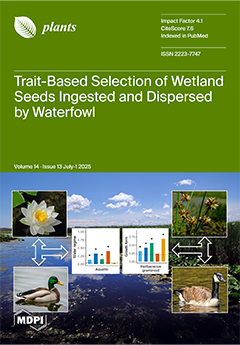Caffeic acid-O-methyltransferase (COMT) is a key enzyme in lignin synthesis and secondary metabolism in plants, and it participates in the regulation of plant growth and development as well as plants’ stress response. To further investigate the function of COMT in grapevine, a total of 124
COMT family genes were identified from three
Vitis species in this study, namely Pinot noir (
Vitis vinifera L.),
Vitis amurensis, and
Vitis riparia. The amino acid sequence encoded by these genes ranged from 55 to 1422 aa, and their molecular mass ranged from 6640.82 to 77,034.43 Da. Subcellular localization prediction inferred that they were mainly located in the plasma membrane and cytoplasm. The prediction of secondary structures showed that α-helix and irregular coiled-coil were primary structural elements. These genes were unevenly distributed across 10 different chromosomes, respectively. Phylogenetic tree analysis of the amino acid sequences of VvCOMT, VaCOMT, VrCOMT, and AtCOMT proteins showed that they were closely related and were divided into four subgroups. The motif distribution was similar among the cluster genes, and the gene sequence was notably conserved. The 124 members of the COMT gene family possessed a variable number of exons, ranging from 2 to 13. The promoter region of all of these
COMTs genes contained multiple cis-acting elements related to hormones (e.g., ABA, IAA, MeJA, GA, and SA), growth and development (e.g., endosperm, circadian, meristem, light response), and various stress responses (e.g., drought, low temperature, wounding, anaerobic, defense, and stress). The intraspecies collinearity analysis suggested that there were one pair, three pairs, and six pairs of collinear genes in
Va, Pinot noir, and
Vr, respectively, and that tandem duplication contributed more to the expansion of these gene family members. In addition, interspecific collinearity revealed that the
VvCOMTs had the strongest homology with the
VaCOMTs, followed by the
VrCOMTs, and the weakest homology with the
AtCOMTs. The expression patterns of different tissues and organs at different developmental stages indicated that the
VvCOMT genes had obvious tissue expression specificity. The majority of
VvCOMT genes were only expressed at higher levels in certain tissues. Furthermore, we screened 13
VvCOMT genes to conduct qRT-PCR verification according to the transcriptome data of
VvCOMTs under abiotic stresses (NaCl, PEG, and cold). The results confirmed that these genes were involved in the responses to NaCl, PEG, and cold stress. This study lays a foundation for the exploration of the function of the COMT genes, and is of great importance for the genetic improvement of abiotic stress resistance in grapes.
Full article






